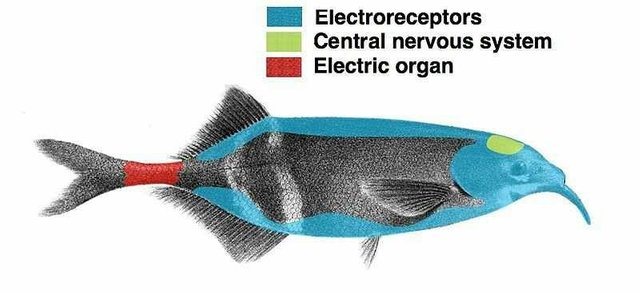Don't be shocked; it's just an electric fish.
The earth is blessed with an abundant volume of water which is classified into different types based on different characteristics. These characteristics may include the speed of flow, the size of the water, the location or even based on the contents dissolved in the water - like salts.
These diverse form of water bodies are also blessed with abundant life form ranging from the microscopic microorganisms to the giant candidates like the giant whale. These aquatic lives come with several interesting facts and maybe some shocking facts – like the electric fish.
Yeah, you read that well. There are fishes that don’t just get named so, but because they have the ability to generate electricity. This post is not to make you scared of going to the beach or swimming in your favorite pool. But there may be something you just don’t know yet.
Electric fish: what are they?
 Creative Commons Attribution 3.0 Unported: wikipedia
Creative Commons Attribution 3.0 Unported: wikipedia
For some of you who may be familiar with the concept of electric fishes, the electric eel may be the first name that comes into your head. You’re a genius for knowing that. However, the electric eel is not the only fish capable of producing electric charges. So let’s get charged up!
When we talk about electricity in fishes, you should know that it is of two types. Some are capable of producing it while others are capable of detecting it. I, however, believe that the former always do both, i.e., capable of producing and detecting electric signals.
When next you see a fish, you may want to take a closer look at it. Examine closely the side of the fish, you may see a long thin line that runs across its side. You may have to look deeper depending on the type of fish you lay your hands upon because the size and conspicuousness differ with fish species. This is actually not a line but pores with sensitive nerves used mainly to sense movement and change in vibration in the water. But don’t feel bad for calling it a line because even science calls it a lateral line. The sharks, for instance, have highly specialized these cells which makes them able to detect not only vibrations but electric current. This is important to the fish when it comes to detecting the exact location of its prey. Genius, right?
Some examples of fish I like you to know
- Electric eel
On top of this list is the electric eel and probably the most famous –at least, some of my friends think so. The ichthyologist calls it Electrophorus electricus. You probably don’t need prior knowledge of Greek to tell that the name has its stem from the similar root as electricity. Some people think it looks like a snake which they are right. However, if you’ve seen an eel you will agree with me that it looks more like one. But this striking resemblance does not mean that the true eel and the electric eel are close cousins. In fact, the catfish may claim a stronger family tie than the true eel. They are obligatory air breather so they are able to survive in muddy waters.
 Creative Commons Attribution-Share Alike 3.0 Unported: wikipedia
Creative Commons Attribution-Share Alike 3.0 Unported: wikipedia
- Mormyridae Maybe not as popular as the electric eel to you but they are another family of fish capable of producing an electric charge. You’ll probably want to forget the name Mormyridae and stick to the common names like elephant fish or the trunkfish. A name which better suits the appearance of the fish’ snout. It is common in most Nigerian water bodies and especially the Niger River. It’s also a very tasty fish when smoked (I was fortunate to taste this fish last year).
- Electric ray You may have come across a flatfish, they look like a kite in the community aquarium or maybe on TV. These fishes are known as a ray with a flat body and the kite like pectoral fin joint to their head. There are species of the ray known as the electric ray known to produce electric discharges too.
- African Knife fish and Electric Catfish
The African knife fish of the genus Gymnarchus is also included in the list of fishes capable of producing electric current. The last on this list is the electric catfish. However, this is not an exclusive list. The electric catfish can be easily identified by the presence of black patches on its body and also the absence of the dorsal fin. I was lucky to see one during one during a field trip to one of the villages along the river Niger in Niger state.
 Picture taken by me at Fakun, along Kainji, Niger State, Nigeria. (Notice the two red mark on the picture. The first points to electric catfish and the second to a type elephantfish.
Picture taken by me at Fakun, along Kainji, Niger State, Nigeria. (Notice the two red mark on the picture. The first points to electric catfish and the second to a type elephantfish.
How do they produce electricity?
Not all electric fish produces the same amount of electric discharge. Some produce a weak electrical field while others produce a stronger one. They are simply named by the strength of the electric field they are capable of producing as either weakly or strongly electric fish.Weakly electric fish have been suggested to use their electricity producing ability mainly to detect prey and also avoid predation. From the examples of fish listed in this post, the Elephant fish and the Knifefish will fit better into this classification with typically an electric discharge less than a volt.
The strongly electric fish are well able to use their electricity generating ability to locate the location of their prey as well as capturing their prey by producing electric charges. According to National Geographic, the electric eel may produce up to 600volt that can last for only 2msec.
These fishes produce electricity from an organ simply named the electric organ. They are made up of highly specialized cells which perform this function. They are made up of several cells stacked up like batteries which produce the electric field. The fish releases positive ions through this organ thereby creating some sort of potential difference around them.
The knife fish, for instance, has its electric organ located around its tail region. The fish vary the charge around this region of its body to be different from the head thereby causing an electric field. The electric eel’s organ makes up the bulk of the fish’ body. This is divided into three parts which are capable of producing both high and low voltage of electricity.
Encounter with human
Electric fish May not be as dangerous as people think. There are only a few recorded cases of human encounter with these shocking creatures. The severity of the shock will depend on the size of the fish as larger fish can cause severe shock than smaller ones. Also, the current that passes through the body is very important which will be reduced because of the body resistance and the short duration of the electric discharge. Possible cause of death will be multiple shocks by these fish causing the victim to drown after suffering such attack. Fishermen may be caught unaware touching the electric catfish will involuntarily jolt as a response to the shock.
This shocking video was filmed by some people who were hunting for an electric eel. One of them decided to be the bait while the others where all ready to drag him back to shore with a rope tied to his waist. Well, he got the shock of his life but he was quickly dragged to shore while the others killed the fish.
This post has been voted on by the SteemSTEM curation team and voting trail in collaboration with @curie.
If you appreciate the work we are doing then consider voting both projects for witness by selecting stem.witness and curie!
For additional information please join us on the SteemSTEM discord and to get to know the rest of the community!
Thanks for using eSteem!
Your post has been voted as a part of eSteem encouragement program. Keep up the good work! Install Android, iOS Mobile app or Windows, Mac, Linux Surfer app, if you haven't already!
Learn more: https://esteem.app
Join our discord: https://discord.gg/8eHupPq
Congratulations @mr-aaron! You have completed the following achievement on the Steem blockchain and have been rewarded with new badge(s) :
Click here to view your Board
If you no longer want to receive notifications, reply to this comment with the word
STOPTo support your work, I also upvoted your post!